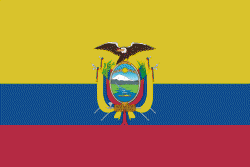Gualaceo Canton (Cantón Gualaceo)
 |
 |
Gualaceo has 38.587 inhabitants, is crossed by the three rivers Santa Bárbara, San Francisco and Guaymincay, and carries the nickname “El Jardin del Azuay” due to the natural surroundings and mountains. The city currently holds the title of Cultural Heritage Site of the Nation. Gualaceo became an independent canton on the 25 June 1824.
The etymology of the name, "GUALACEO", is derived from a cañari word modified from the Chibcha word Gualaca meaning “macaw’s settlement”; it was a Cañari settlement for long time, belonging to the Kingdom of Quito, until it was conquered by the Incas.
In the year 1531 - 1532, the Inca Empire of Tahuantinsuyo ended with the death of the last monarch Atahualpa, at the hands of the conquerors that came from the old world, led by Sebastián de Benalcázar whose presence marks the start of the Spanish colonization.
With the arrival of the Spaniards begins the phase of the colony of Gualaceo. The conquerors penetrated to all the corners of the Kingdom of Quito, and Sebastián of Banalcázar, assisted by the caciques (overlords) Llivicura (Gualaceo) and Duma (Sigsig) and other cañaris, explored the valley of the Tomebamba; they climbed the slopes of Dotaxí and Cristo Rey and arrived at Gualaceo, a marvelous place due to the landscape and the rivers that reflected the shine of gold.
In April 1534, Benalcázar and his troops established the first mining camp and settlement at the edges of the wider river named Santa Barbara; Benalcázar also named the tributaries San Francisco and San José, while the other 2 tributaries still conserve their cañari names: Guaymincay and Shío.
The Spaniards remained in the valley of Gualaceo for many years, documents suggest that from 1534 until 1549 was only a mining camp without an organized population.
210 years passed since the first mining settlement was established until,in July 1757, Gualaceo was elevated to an ecclesiastical parish of Cuenca, governed by a party judge lieutenant Manuél Dávila Chica and its vicar José Villavicencio.
Manuel Dávila Chica, as leader of the region, contributed to the independence of Cuenca, with men, horses, cedar wood, walnuts and other foodstuffs.
The Independence of Cuenca and the whole Ecuador led to a more republican style of government, initially belonging to the Great Colombia with the Departments of Venezuela, Cundinamarca and Quito.
Map - Gualaceo Canton (Cantón Gualaceo)
Map
Country - Ecuador
Currency / Language
| ISO | Currency | Symbol | Significant figures |
|---|---|---|---|
| USD | United States dollar | $ | 2 |
| ISO | Language |
|---|---|
| ES | Spanish language |

















